Thymeleaf从入门到精通
什么是Thymeleaf
大家好,我是bigsai,今天我们来学习Thymeleaf,如果你对Thymeleaf比较陌生也不要紧,它很容易学习与理解,并有着自己鲜明的特色。
 开始之前,我们依旧问一个问题: 什么是Thymeleaf?
开始之前,我们依旧问一个问题: 什么是Thymeleaf?
Java模板引擎
模板引擎介绍
模板引擎?你可能第一次听说模板引擎,估计你会禁不住想问: 什么是模板引擎?
- 模板引擎 (这里特指用于Web开发的模板引擎)是为了使用户界面与业务数据(内容)分离而产生的,它可以生成特定格式的文档,用于网站的模板引擎就会生成一个标准的html文档。从字面上理解
模板引擎,最重要的就是模板二字,这个意思就是做好一个模板后套入对应位置的数据,最终以html的格式展示出来,这就是模板引擎的作用。 - 对于模板引擎的理解,可以这样形象的做一个类比: 开会! 相信你在上学初高中时候每次开会都要提前布置场地、拿小板凳、收拾场地。而你上了大学之后每次开会再也不去大操场了,每次开会都去学校的大会议室,桌子板凳音响主席台齐全,来个人即可,还可复用……。模板引擎的功能就类似我们的会议室开会一样开箱即用,将模板设计好之后直接填充数据即可而不需要重新设计整个页面。提高页面、代码的复用性。
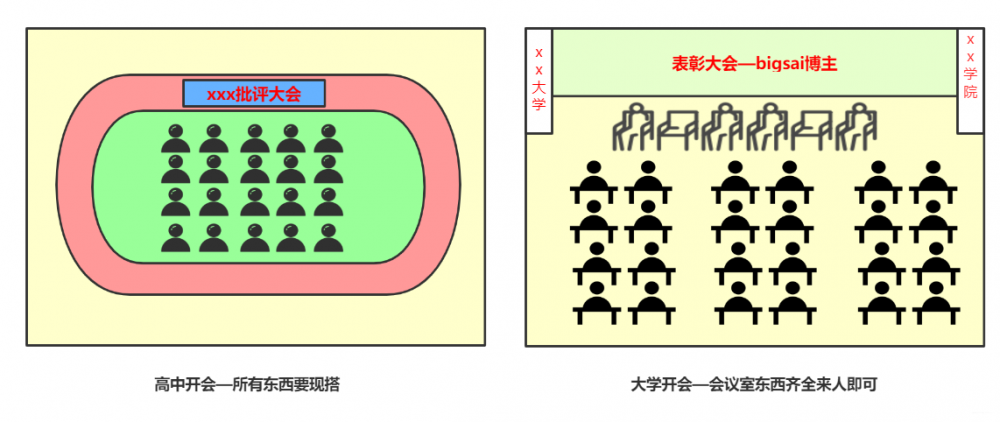
不仅如此,在Java中模板引擎还有很多,模板引擎是动态网页发展进步的产物,在最初并且流传度最广的 jsp 它就是一个模板引擎。jsp是官方标准的模板,但是由于jsp的缺点比较多也挺严重的,所以很多人弃用jsp选用第三方的模板引擎,市面上开源的第三方的模板引擎也比较多,有 Thymeleaf、FreeMaker、Velocity 等模板引擎受众较广。
听完了模板引擎的介绍,相信你也很容易明白了模板引擎在web领域的主要作用:让网站实现界面和数据分离,这样大大提高了开发效率,让代码重用更加容易。
Thymeleaf介绍
上面知晓了模板引擎的概念和功能,你也知道Thymeleaf是众多模板引擎的一种,你一定会好奇想深入学习Thymeleaf的方方面面。从官方的介绍来看,Thymeleaf的目标很明确:
- Thymeleaf的主要目标是为您的开发工作流程带来优雅自然的模板-HTML可以在浏览器中正确显示,也可以作为静态原型工作,从而可以在开发团队中加强协作。
- Thymeleaf拥有适用于Spring Framework的模块,与您喜欢的工具的大量集成以及插入您自己的功能的能力,对于现代HTML5 JVM Web开发而言,Thymeleaf是理想的选择——尽管它还有很多工作要做。
并且随着市场使用的验证Thymeleaf也达到的它的目标和大家对他的期望,在实际开发有着广泛的应用。Thymeleaf作为被Springboot官方推荐的模板引擎,一定有很多过人和不寻同之处:
- 动静分离: Thymeleaf选用html作为模板页,这是任何一款其他模板引擎做不到的!Thymeleaf使用html通过一些特定标签语法代表其含义,但并未破坏html结构,即使无网络、不通过后端渲染也能在浏览器成功打开,大大方便界面的测试和修改。
- 开箱即用: Thymeleaf提供标准和Spring标准两种方言,可以直接套用模板实现JSTL、 OGNL表达式效果,避免每天套模板、改JSTL、改标签的困扰。同时开发人员也可以扩展和创建自定义的方言。
- Springboot官方大力推荐和支持,Springboot官方做了很多默认配置,开发者只需编写对应html即可,大大减轻了上手难度和配置复杂度。

此外,Thymeleaf在曾经还有一次大的版本升级,从Thymeleaf2.0—>Thymeleaf3.0。在Thymeleaf2.0时代,Thymeleaf基于xml实现,虽然它带来了许多出色强大的功能,但有时会降低性能效率,那个时候Thymeleaf的性能真的太差而被很多人所吐槽带来了很不好的印象。
但是Thymeleaf3.0对比Thymeleaf2.0有着翻天覆地的变化,几乎是全部重写了整个Thymeleaf引擎,在性能、效率上相比Thymeleaf2有了很大改善,能够满足更多项目的需求,且Thymeleaf3.0不再基于xml所以在html环境下有着更宽松的编程环境。
此外,Thymelaf3.0在方言、独立于Java Servlet API、重构核心API、片段表达等方面有着巨大提升和改善,具体可以参看 Thymeleaf3十分钟参考指南 。

学习Thymeleaf必知的知识点
Thymeleaf模板的运行离不开web的环境,所以你需要对相关知识学习理解才能更好的有助于你对Thymeleaf的学习和认知。
Springboot
相信你对Springboot都很熟悉,我们使用Thymeleaf大多情况都是基于Springboot平台的,并且Thymeleaf的发展推广也离不开Springboot官方得支持,且本文的实战部分也是基于Springboot平台。
而Spring Boot是由Pivotal团队提供的全新框架,其设计目的是用来简化新Spring应用的初始搭建以及开发过程。该框架使用了特定的方式来进行配置,从而使开发人员不再需要定义样板化的配置。通过这种方式,Spring Boot致力于在蓬勃发展的快速应用开发领域(rapid application development)成为领导者。
简而言之,Springboot是当前web开发主流,且其简化了Spring的配置让开发者能够更容易上手Web项目的开发。且Thymeleaf能够快速整合入Springboot,使用方便快捷。

MVC介绍
我们使用的Thymeleaf模板引擎在整个web项目中起到的作用为视图展示(view),谈到视图就不得不提起模型(model)以及控制器(view),其三者在web项目中分工和职责不同,但又相互有联系。三者组成当今web项目较为流行的MVC架构。
MVC全名是Model View Controller,是模型(model)-视图(view)-控制器(controller)的缩写,其中:
- Model(模型)表示应用程序核心(用来存储数据供视图层渲染)。
- View(视图)显示数据,而本篇使用的就是Thymeleaf作为视图。
- Controller(控制器)处理输入请求,将模型和视图分离。
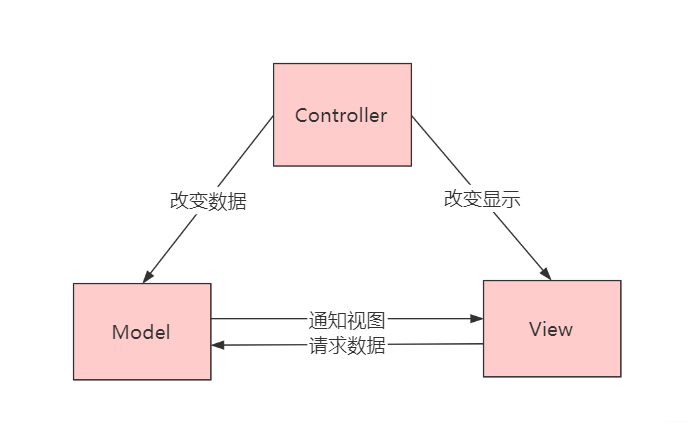
使用MVC设计模式程序有很多优点,比如降低程序耦合、增加代码的复用性、降低开发程序和接口的成本,并且通过这样分层结构在部署维护能够提供更大的便捷性。
在Java web体系最流行的MVC框架无疑就是Springmvc框架了,在项目中经常配合模板引擎使用或者提供Restful接口。在下面案例Thymeleaf同样使用Springmvc作为MVC框架进行控制。
动静分离
你可能还是不明白什么才是真正的动静分离,其实这个主要是由于Thymeleaf模板基于html,后缀也是 .html ,所以这样就会产生一些有趣的灵魂。
对于传统jsp或者其他模板来说,没有一个模板引擎的后缀为 .html ,就拿jsp来说jsp的后缀为 .jsp ,它的本质就是将一个html文件修改后缀为 .jsp ,然后在这个文件中增加自己的语法、标签然后执行时候通过后台处理这个文件最终返回一个html页面。
浏览器无法直接识别 .jsp 文件,需要借助网络(服务端)才能进行访问;而Thymeleaf用html做模板可以直接在浏览器中打开。开发者充分考虑html页面特性,将Thymeleaf的语法通过html的标签属性来定义完成,这些标签属性不会影响html页面的完整性和显示。如果通过后台服务端访问页面服务端会寻找这些标签将服务端对应的数据替换到响应位置实现动态页面!大体区别可以参照下图:
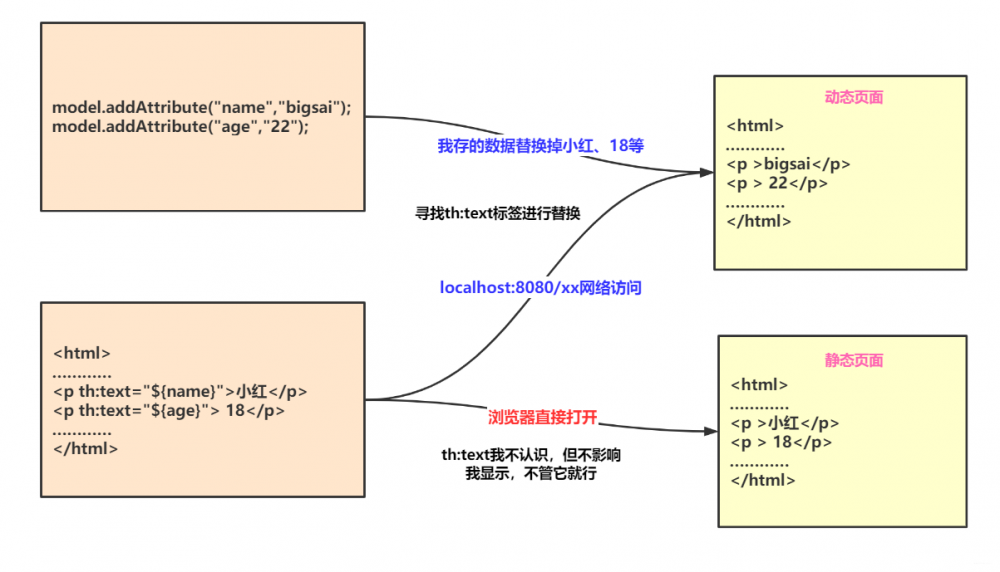
上图的意思就是如果直接打开这个html那么浏览器会对 th 等标签忽视而显示原始的内容。如果通过服务端访问那么服务端将先寻找 th 标签将服务端储存的数据替换到对应位置。具体效果可以参照下图,下图即为一个动静结合的实例。
- 右上角为动态页面通过服务端访问,数据显示为服务端提供的数据,样式依然为html的样式
- 右下角为静态页面可通过浏览器直接打开,数据为初始的数据
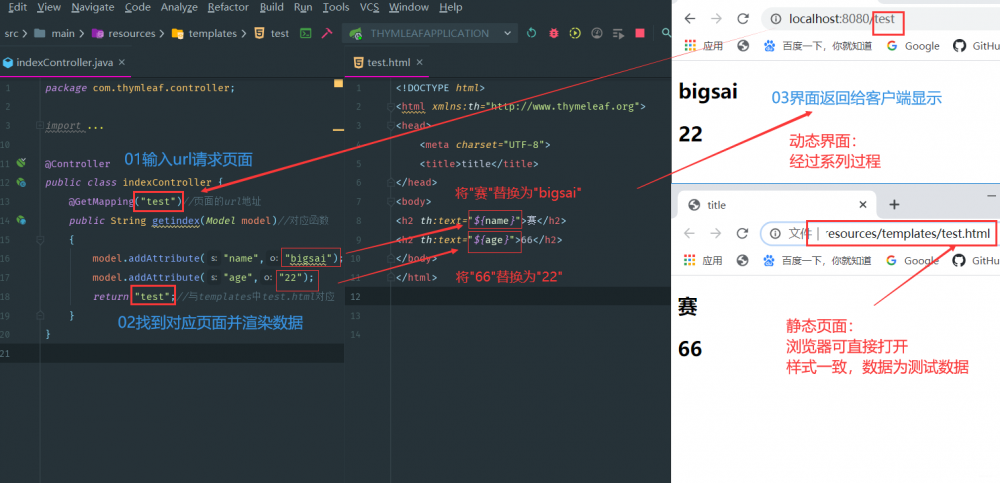
动态页面每次修改打开都需要重新启动程序、输入链接,这个过程其实是相对漫长的。如果界面设计人员用这种方式进行页面设计时间成本高并且很麻烦,可通过静态页面设计样式,设计完成通过服务端访问即可达成目标UI的界面和应用,达到动静分离的效果。这个特点和优势是所有模板引擎中Thymeleaf所独有的!
第一个Thymeleaf程序
上面既然简单介绍了Thymeleaf,下面咱们着手实战第一个Thymeleaf程序。考虑到Thymeleaf被Springboot官方推荐,并且Springboot已成为javaweb领域必不可少的技术点,咱们就用IDEA基于Springboot构建第一个Thymeleaf程序。Thymeleaf提供了一组Spring集成,使您可以将其用作Spring MVC应用程序中JSP的全功能替代品。对于构建一个完整程序,创建第一个Thymeleaf程序需要以下几个步骤:
- 创建程序,添加依赖
- 编写Controller
- 编写Thymeleaf页面
- 访问页面
创建程序,添加依赖
首先,打开你的IDEA创建新项目,选择Spring Initializr方式创建Springboot项目 ,然后点击next。具体如下图所示。
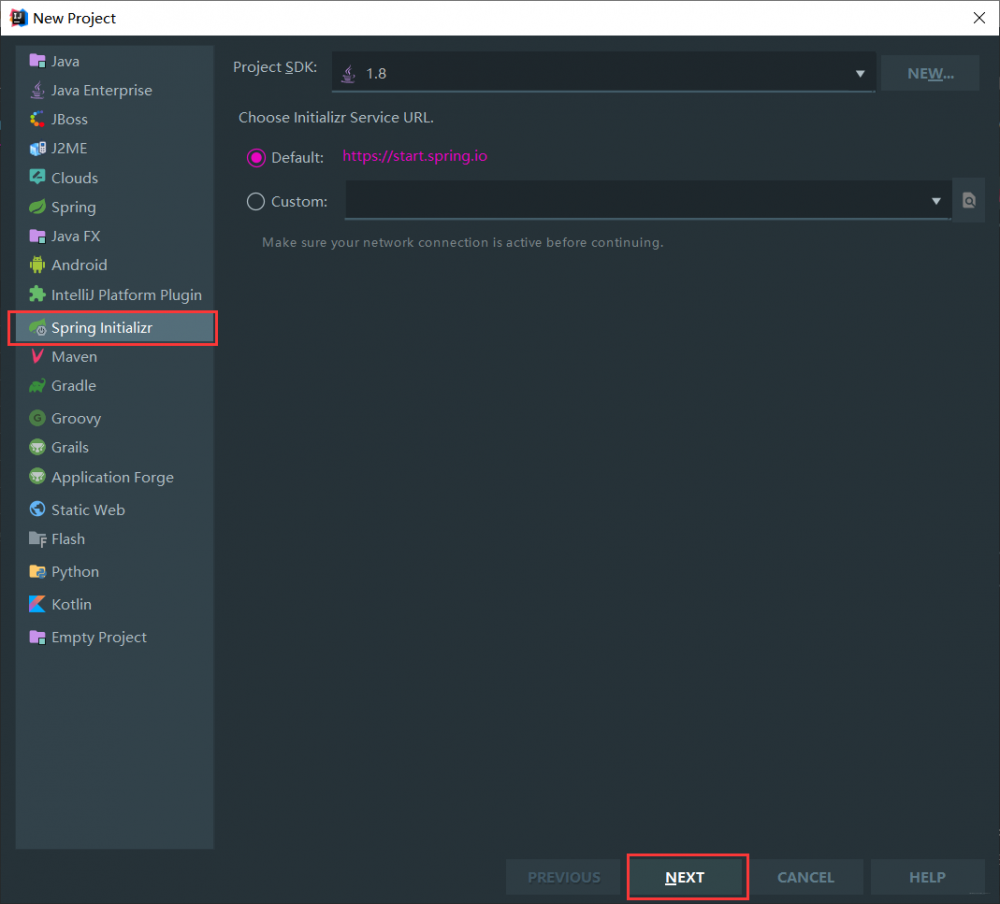
点击next之后,我们进行next 填写好Group(一般com或者com.xxx)和Aritifact(一般项目名)创建。其他地方没有特殊情况不需要修改,具体如下图:
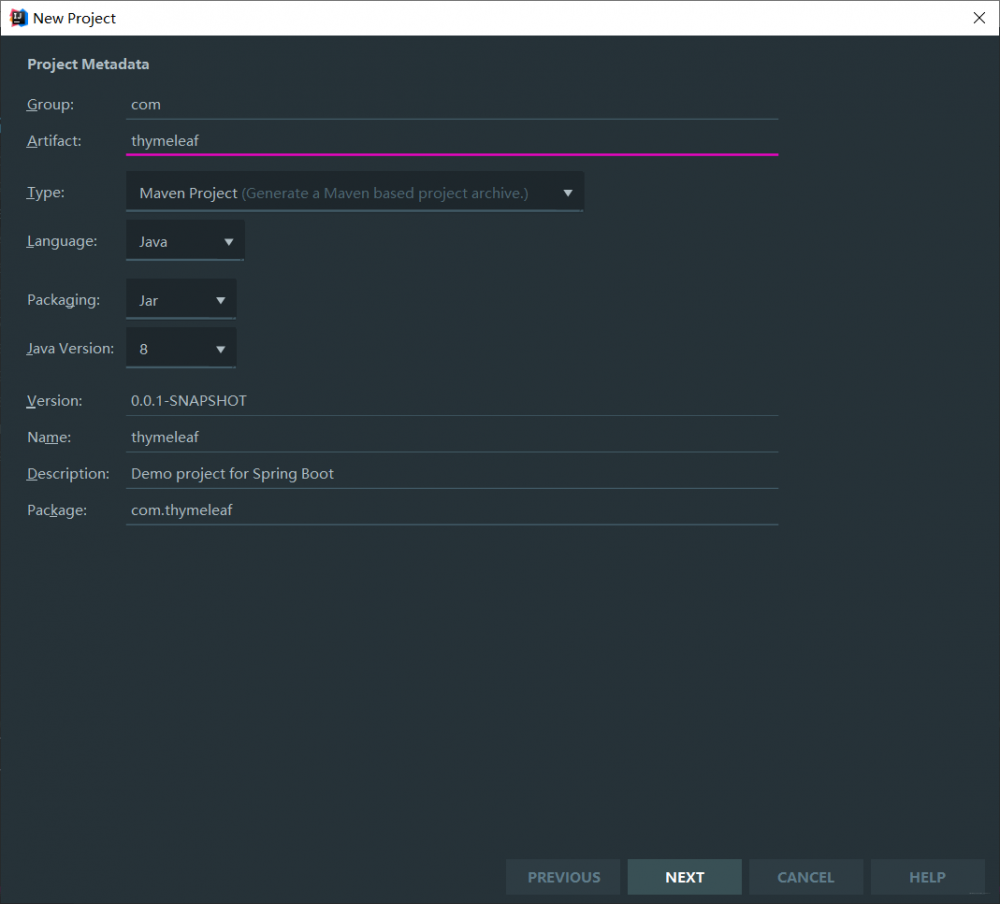 IDEA的编译器做的很友好,可以直接选择热门的依赖而不需要去进行寻找,我们勾选其中Web 模块的Spring web依赖以及Template 模块的Thymeleaf依赖。finish 即可:
IDEA的编译器做的很友好,可以直接选择热门的依赖而不需要去进行寻找,我们勾选其中Web 模块的Spring web依赖以及Template 模块的Thymeleaf依赖。finish 即可:
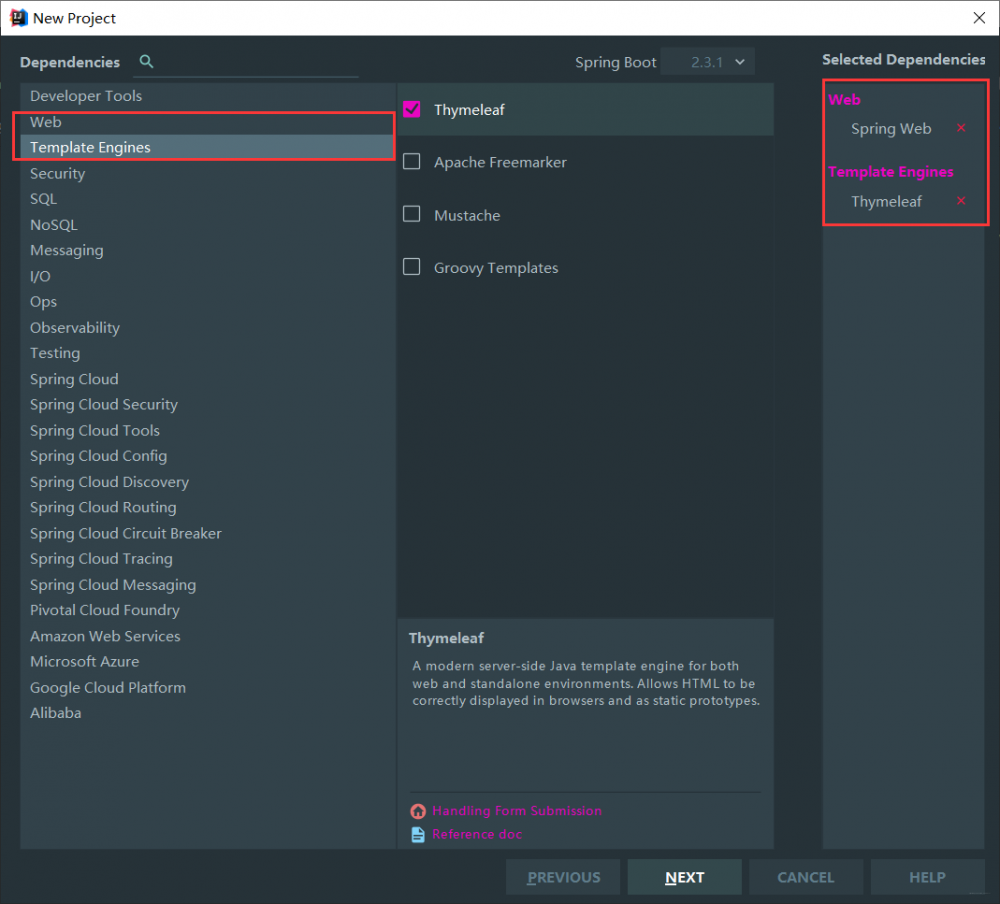
当然,如果你创建项目时没有勾选依赖也不要紧,在pom.xml中添加以下依赖:
<dependency> <groupId>org.springframework.boot</groupId> <artifactId>spring-boot-starter-thymeleaf</artifactId> </dependency> <dependency> <groupId>org.springframework.boot</groupId> <artifactId>spring-boot-starter-web</artifactId> </dependency>
就这样,程序创建完毕,依赖也成功添加,你就可以在此基础上正式开始你的个性化操作。
编写controller
在编写Controller和Thymeleaf之前,先让你看一下最终项目的目录结构,有个初略的印象和概念:

在其中:
- pom.xml :是项目中的Maven依赖,因为Springboot使用Maven来管理外部jar包依赖,我们只需填写依赖名称配置即可引入该依赖,在本系统中引入Spring web模块(Springmvc)和Thymeleaf的依赖.我们不需要自己去招相关jar包。
- application.properties : 编写Springboot与各框架整合的一些配置内容。
- controller :用来编写控制器,主要负责处理请求以及和视图(Thymeleaf)绑定。
- static :用于存放静态资源,例如html、JavaScript、css以及图片等。
- templates :用来存放模板引擎Thymeleaf(本质依然是.html文件)
项目基于Springboot框架,且选了Spring web(Springmvc)作为mvc框架,其中Thymeleaf就是v(view)视图层,我们需要在controller中指定Thymeleaf页面的url,然后再Model中绑定数据。
我们在com.Thymeleaf文件下创建controller文件夹,在其中创建urlController.java的controller文件,文件内容(代码)为:
package com.Thymeleaf.controller;
import org.springframework.stereotype.Controller;
import org.springframework.ui.Model;
import org.springframework.web.bind.annotation.GetMapping;
@Controller
public class urlController {
@GetMapping("index")//页面的url地址
public String getindex(Model model)//对应函数
{
model.addAttribute("name","bigsai");
return "index";//与templates中index.html对应
}
}
上述代码就是一个完整的controller。部分含义如下:
- @controller 注解的意思就是声明这个java文件为一个controller控制器。
- @GetMapping("index") 其中@GetMapping的意思是请求的方式为get方式(即可通过浏览器直接请求),而里面的index表示这个页面(接口)的url地址(路径)。即在浏览器对项目网页访问的地址。
- getindex() 是@GetMapping("index")注解对应的函数,其类型为String类型返回一个字符串,参数Model类型即用来储存数据供我们Thymeleaf页面使用。
- model.addAttribute("name","bigsai") 就是Model存入数据的书写方式,Model是一个特殊的类,相当于维护一个Map一样,而Model中的数据通过controller层的关联绑定在view层(即Thymeleaf中)可以直接使用。
- return "hello" :这个index就是在templates目录下对应模板(本次为Thymeleaf模板)的名称,即应该对应hello.html这个Thymeleaf文件(与页面关联默认规则为:templates目录下
返回字符串.html)。
编写Thymeleaf页面
咱们在项目的resources目录下的templates文件夹下面创建一个叫index.html的文件,咱们在这个html文件中的 <html> 标签修改为 <html xmlns:th="http://www.thymeleaf.org"> 这样在Thymeleaf中就可以使用Thymeleaf的语法和规范啦。
对于第一个Thymelaf程序,你只需将index.html文件改成这样即可:
<!DOCTYPE html>
<html xmlns:th="http://www.thymeleaf.org">
<head>
<meta charset="UTF-8">
<title>title</title>
</head>
<body>
hello 第一个Thymeleaf程序
<div th:text="${name}">name是bigsai(我是离线数据)</div>
</body>
</html>
你可能会对 <div th:text="${name}">name是bigsai(我是离线数据)</div> 感到陌生,这个标签中的 th:text="${name}" 就是Thymeleaf取值的一个语法,这个值从后台渲染而来(前面controller中在Model中存地值),如果没网络(直接打开html文件)的时候静态数据为: name是bigsai(我是离线数据) 。而如果通过网络访问那么内容将是前面在controller的Model中储存的 bigsai 。
启动程序
这样写好之后咱们执行这个Springboot程序。通过网络访问 http://localhost:8080/index
 上图 左侧为直接打开的静态页面 ,而 右侧是通过网络访问服务端返回的动态界面 ,可以看的到,界面的内容和我们预期一致,左右两侧也正是静动态页面的两个代表。
上图 左侧为直接打开的静态页面 ,而 右侧是通过网络访问服务端返回的动态界面 ,可以看的到,界面的内容和我们预期一致,左右两侧也正是静动态页面的两个代表。
通过以上的步骤,你就完成了第一个Thymeleaf程序并且能够成功运行。入门便悄然开始!

Thymeleaf语法详解
上面虽然完成了第一个Thymeleaf程序,但是那样远远满足不了我们在项目中使用Thymeleaf,所以我们要对Thymeleaf的语法规则进行更详细的学习。
配置
虽然Springboot官方对Thymeleaf做了很多默认配置,但咱们引入Thymeleaf的jar包依赖后很可能根据自己特定需求进行更细化的配置,例如页面缓存、字体格式设置等等。
Springboot官方提供的配置内容有以下:
# THYMELEAF (ThymeleafAutoConfiguration) spring.thymeleaf.cache=true # Whether to enable template caching. spring.thymeleaf.check-template=true # Whether to check that the template exists before rendering it. spring.thymeleaf.check-template-location=true # Whether to check that the templates location exists. spring.thymeleaf.enabled=true # Whether to enable Thymeleaf view resolution for Web frameworks. spring.thymeleaf.enable-spring-el-compiler=false # Enable the SpringEL compiler in SpringEL expressions. spring.thymeleaf.encoding=UTF-8 # Template files encoding. spring.thymeleaf.excluded-view-names= # Comma-separated list of view names (patterns allowed) that should be excluded from resolution. spring.thymeleaf.mode=HTML # Template mode to be applied to templates. See also Thymeleaf's TemplateMode enum. spring.thymeleaf.prefix=classpath:/templates/ # Prefix that gets prepended to view names when building a URL. spring.thymeleaf.reactive.chunked-mode-view-names= # Comma-separated list of view names (patterns allowed) that should be the only ones executed in CHUNKED mode when a max chunk size is set. spring.thymeleaf.reactive.full-mode-view-names= # Comma-separated list of view names (patterns allowed) that should be executed in FULL mode even if a max chunk size is set. spring.thymeleaf.reactive.max-chunk-size=0 # Maximum size of data buffers used for writing to the response, in bytes. spring.thymeleaf.reactive.media-types= # Media types supported by the view technology. spring.thymeleaf.servlet.content-type=text/html # Content-Type value written to HTTP responses. spring.thymeleaf.suffix=.html # Suffix that gets appended to view names when building a URL. spring.thymeleaf.template-resolver-order= # Order of the template resolver in the chain. spring.thymeleaf.view-names= # Comma-separated list of view names (patterns allowed) that can be resolved.
上面的配置有些我们可能不常使用,因为Springboot官方做了默认配置大部分能够满足我们的使用需求,但如果你的项目有特殊需求也需要妥善使用这些配置。
比如 spring.thymeleaf.cache=false 是否允许页面缓存的配置,我们在开发时候要确保页面是最新的所以需要禁用缓存;而在上线运营时可能页面不常改动为了减少服务端压力以及提升客户端响应速度会允许页面缓存的使用。
再比如在开发虽然我们大部分使用UTF-8多一些,我们可以使用 spring.thymeleaf.encoding=UTF-8 来确定页面的编码,但如果你的项目是GBK编码就需要将它改成GBK。
另外Springboot默认模板引擎文件是放在templates目录下: spring.thymeleaf.prefix=classpath:/templates/ ,如果你有需求将模板引擎也可修改配置,将templates改为自己需要的目录。同理其他的配置如果需要自定义化也可参照上面配置进行修改。
常用标签
咱们上面知道Thymeleaf通过特殊的标签来寻找属于Thymeleaf的部分,并渲染该部分内容,而除了上面展示过的 th:text 之外还有很多常用标签,并且Thymeleaf也主要通过标签来识别替换对应位置内容,Thymeleaf标签有很多很多,功能也很丰富,这里列举一些比较常用的标签如下:
| 标签 | 作用 | 示例 |
|---|---|---|
| th:id | 替换id | <input th:id="${user.id}"/> |
| th:text | 文本替换 | <p text:="${user.name}">bigsai</p> |
| th:utext | 支持html的文本替换 | <p utext:="${htmlcontent}">content</p> |
| th:object | 替换对象 | <div th:object="${user}"></div> |
| th:value | 替换值 | <input th:value="${user.name}" > |
| th:each | 迭代 | <tr th:each="student:${user}" > |
| th:href | 替换超链接 | <a th:href="@{index.html}">超链接</a> |
| th:src | 替换资源 | <script type="text/javascript" th:src="@{index.js}"></script> |
链接表达式: @{…}
上面我们已经学习到Thymeleaf是一个基于html的模板引擎,但是我们还是需要加入特定标签来声明和使用Thymeleaf的语法。我们需要在Thymeleaf的头部加Thymeleaf标识:
<html xmlns:th="http://www.thymeleaf.org">
在Thymeleaf 中,如果想引入链接比如link,href,src,需要使用 @{资源地址} 引入资源。其中资源地址可以static目录下的静态资源,也可以是互联网中的绝对资源。
引入css
<link rel="stylesheet" th:href="@{index.css}">
引入JavaScript:
<script type="text/javascript" th:src="@{index.js}"></script>
超链接:
<a th:href="@{index.html}">超链接</a>
这样启动程序访问页面,页面的内容就自动修改成标准html语法格式的内容:
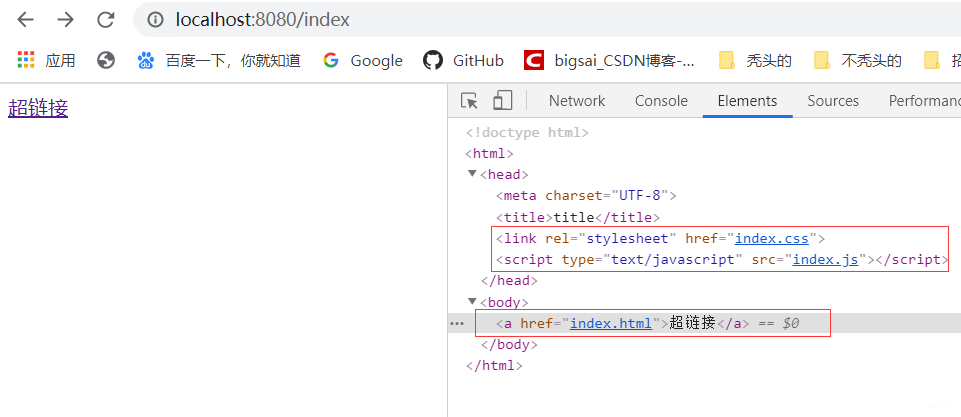
变量表达式: ${...}
在Thymeleaf中可以通过${…}进行取值,这点和ONGL表达式语法一致。
例如咱们创建这么一个对象:
public class user {
private String name;
private int age;
private String detail;
public user(String name, int age, String detail) {
this.name = name;
this.age = age;
this.detail = detail;
}
public String getName() {
return name;
}
public void setName(String name) {
this.name = name;
}
public int getAge() {
return age;
}
public void setAge(int age) {
this.age = age;
}
public String getDetail() {
return detail;
}
public void setDetail(String detail) {
this.detail = detail;
}
}
咱们为了测试先在Model中添一些数据:
@GetMapping("index")//页面的url地址
public String getindex(Model model)//对应函数
{
user user1=new user("bigsai",22,"一个幽默且热爱java的社会青年");
List<String>userList=new ArrayList<>();
userList.add("zhang san 66");
userList.add("li si 66");
userList.add("wang wu 66");
Map<String ,String>map=new HashMap<>();
map.put("place","博学谷");
map.put("feeling","very well");
//数据添加到model中
model.addAttribute("name","bigsai");//普通字符串
model.addAttribute("user",user1);//储存javabean
model.addAttribute("userlist",userList);//储存List
model.addAttribute("map",map);//储存Map
return "index";//与templates中index.html对应
}
取普通字符串:
如果在controller中的Model直接存储某字符串,我们可以直接 ${对象名} 进行取值。完整代码如下:
<h2>普通字符串</h2>
<table border="0">
<tr>
<td th:text="'我的名字是:'+${name}"></td>
</tr>
</table>
运行结果为:

取JavaBean对象:
取JavaBean对象也很容易,因为JavaBean自身有一些其他属性,所以咱们就可以使用 ${对象名.对象属性} 或者 ${对象名['对象属性']} 来取值,这和JavaScript语法是不是很相似呢!除此之外,如果该JavaBean如果写了get方法,咱们也可以通过get方法取值例如 ${对象.get方法名} 完整代码如下:
<h2>JavaBean对象</h2>
<table bgcolor="#ffe4c4" border="1">
<tr>
<td>介绍</td>
<td th:text="${user.name}"></td>
</tr>
<tr>
<td>年龄</td>
<td th:text="${user['age']}"></td>
</tr>
<tr>
<td>介绍</td>
<td th:text="${user.getDetail()}"></td>
</tr>
</table>
运行结果为:
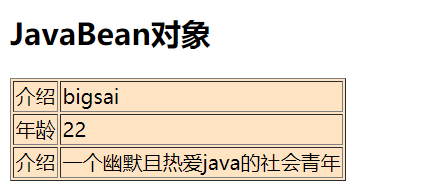
取List集合(each):
因为List集合是个有序列表,里面内容可能不止一个,你需要遍历List对其中对象取值,而遍历需要用到标签: th:each ,具体使用为 <tr th:each="item:${userlist}"> ,其中item就相当于遍历每一次的对象名,在下面的作用域可以直接使用,而userlist就是你在Model中储存的List的名称。完整的代码为:
<h2>List取值</h2>
<table bgcolor="#ffe4c4" border="1">
<tr th:each="item:${userlist}">
<td th:text="${item}"></td>
</tr>
</table>
运行结果为:
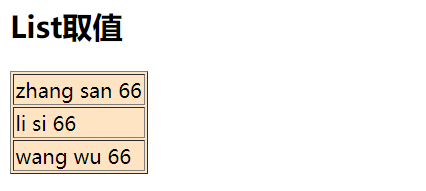
直接取Map:
很多时候我们不存JavaBean而是将一些值放入Map中,再将Map存在Model中,我们就需要对Map取值,对于Map取值你可以 ${Map名['key']} 来进行取值。也可以通过 ${Map名.key} 取值,当然你也可以使用 ${map.get('key')} (java语法)来取值,完整代码如下:
<h2>Map取值</h2>
<table bgcolor="#8fbc8f" border="1">
<tr>
<td>place:</td>
<td th:text="${map.get('place')}"></td>
</tr>
<tr>
<td>feeling:</td>
<td th:text="${map['feeling']}"></td>
</tr>
</table>
运行结果为:
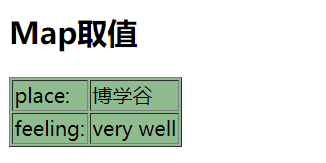
遍历Map:
如果说你想遍历Map获取它的key和value那也是可以的,这里就要使用和List相似的遍历方法,使用 th:each="item:${Map名}" 进行遍历,在下面只需使用 item.key 和 item.value 即可获得值。完整代码如下:
<h2>Map遍历</h2>
<table bgcolor="#ffe4c4" border="1">
<tr th:each="item:${map}">
<td th:text="${item.key}"></td>
<td th:text="${item.value}"></td>
</tr>
</table>
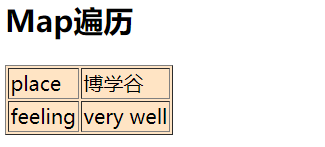
选择变量表达式: *{...}
变量表达式不仅可以写成 ${...} ,而且还可以写成 *{...} 。
但是,有一个重要的区别:星号语法对选定对象而不是整个上下文评估表达式。也就是说,只要没有选定的对象,美元( ${…} )和星号( *{...} )的语法就完全一样。
什么是选定对象?使用 th:object 属性的表达式的结果。就可以选定对象,具体实例如下:
<div th:object="${user}">
<p>Name: <span th:text="*{name}">赛</span>.</p>
<p>Age: <span th:text="*{age}">18</span>.</p>
<p>Detail: <span th:text="*{detail}">好好学习</span>.</p>
</div>
当然 *{…} 也可和 ${…} 混用。上面的代码如果不使用选定对象,完全等价于:
<div >
<p>Name: <span th:text="*{user.name}">赛</span>.</p>
<p>Age: <span th:text="${user.age}">18</span>.</p>
<p>Detail: <span th:text="${user.detail}">好好学习</span>.</p>
</div>
运行结果为:

消息表达: #{...}
文本外部化是从模板文件中提取模板代码的片段,以便可以将它们保存在单独的文件(通常是.properties文件)中,文本的外部化片段通常称为“消息”。通俗易懂得来说 #{…} 语法就是用来 读取配置文件中得数据 的。在Thymeleaf你可以使用 #{...} 语法获取消息,具体实例代码如下:
首先在templates目录下建立 home.properties 中写入以下内容:
bigsai.nane=bigsai bigsai.age=22 province=Jiang Su
在 application.properties 中加入以下内容:
spring.messages.basename=templates/home
这样我们就可以在Thymeleaf中读取配置的文件了,完整代码如下:
<h2>消息表达</h2>
<table bgcolor="#ffe4c4" border="1">
<tr>
<td>name</td>
<td th:text="#{bigsai.name}"></td>
</tr>
<tr>
<td>年龄</td>
<td th:text="#{bigsai.age}"></td>
</tr>
<tr>
<td>province</td>
<td th:text="#{province}"></td>
</tr>
</table>
运行结果为:
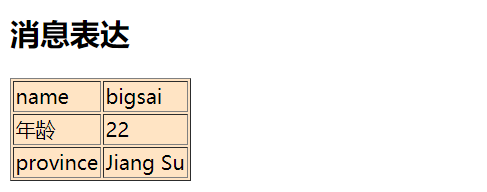
总结
到这里本次Thymeleaf的入门学习就结束了,通过本次学习你可能更深入了解了Thymeleaf以及模板引擎,也对Thymeleaf的动静分离、开箱即用的一些特性估计有了更深入的了解。你也具备Thymeleaf的基本使用能力,能够用Thymeleaf进行网页的快速开发……
但Thymeleaf的内容绝非只有这么一点点,本篇旨在带你从一个对Thymeleaf概念为零的状态到一个能够较为清晰明了的认识和使用Thymeleaf,对于Thymeleaf的内容远远不止上面所涉及到的,对于一些算术运算、条件表达式等等其他内容还需要你自己到Thymeleaf官网去学习研究。
Thymeleaf是一种Java模板引擎,被Springboot官方推荐,大大提高开发效率,提高代码复用率。虽然在当今Ajax更为流行,但对于后端开发工程师掌握Thymeleaf,拥有快速开发网页能力,还是很有必要的!本篇就到这里了,我们下次再见!

欢迎关注微信公众号: bigsai 一个有趣的程序员,更多内容待分享,期待您的关注!

- 本文标签: SpringMVC tag tar src 数据 需求 cache java 实例 本质 开发 网站 管理 ACE App id classpath list 缓存 js build 开发者 代码 bean spring HTML文件 工程师 mina spring集成 cat 领导 http 设计模式 服务端 测试 value JVM https Ajax UI HTML5 JavaScript 目录 遍历 模型 pom 参数 部署 互联网 CSS 推广 灵魂 IO 编译 key ArrayList ip 开源 配置 API message HTML springboot maven REST freemaker 压力 IDE 运营 时间 图片 web XML HashMap servlet 总结 map RESTful 微信公众号 程序员 Spring Boot tab
- 版权声明: 本文为互联网转载文章,出处已在文章中说明(部分除外)。如果侵权,请联系本站长删除,谢谢。
- 本文海报: 生成海报一 生成海报二











![[HBLOG]公众号](https://www.liuhaihua.cn/img/qrcode_gzh.jpg)

